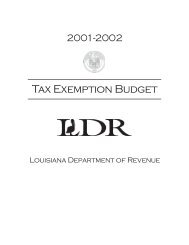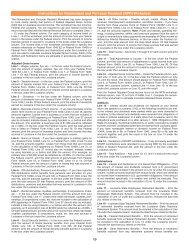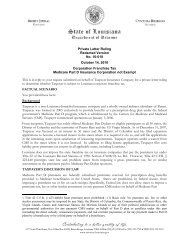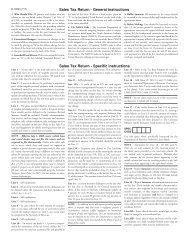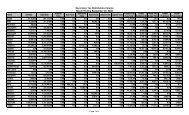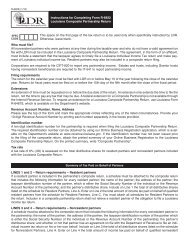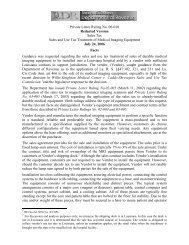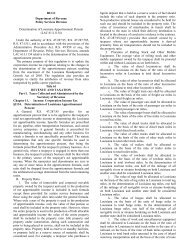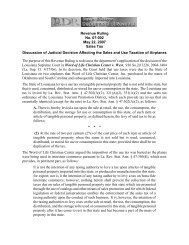Private Letter Ruling Redacted Version No. 08-023 ... - Louisiana
Private Letter Ruling Redacted Version No. 08-023 ... - Louisiana
Private Letter Ruling Redacted Version No. 08-023 ... - Louisiana
Create successful ePaper yourself
Turn your PDF publications into a flip-book with our unique Google optimized e-Paper software.
<strong>Private</strong> <strong>Letter</strong> <strong>Ruling</strong><strong>Redacted</strong> <strong>Version</strong><strong>No</strong>. <strong>08</strong>-<strong>023</strong>Corporation Income Tax and Franchise Tax and Individual Income TaxCredit for the Rehabilitation of Historic Structures in Downtown Development Districts<strong>No</strong>vember 5, 20<strong>08</strong>This is in reply to your request for a private letter ruling regarding the Downtown DevelopmentDistrict Historic Structure Rehabilitation Tax Credit (the “Historic Tax Credit”) authorized by La.R.S. 47:6019.Factual ScenarioYou provided these facts.STATEMENT OF FACTS:(1) Developer, a <strong>Louisiana</strong> limited liability company, is syndicating the acquisition andredevelopment of land and a building in a city in <strong>Louisiana</strong> (the “Project”) situated within the<strong>Louisiana</strong> Downtown Development District (the “District”).(2) The building (the “Structure”) was originally constructed in 19XX, with subsequentadditions.(3) Pursuant to La. R.S. 47:6019A(2)(a), Developer has submitted an application to the<strong>Louisiana</strong> Division of Historic Preservation (“DHP”) for a certification that the Structurecontributes to the historical significance of the District, and DHP has approved such application asevidenced by its execution and approval of Parts 1 and 2 of Developer’s Historic PreservationCertification Application with respect to the Structure.(4) Based on the amount of “eligible costs and expenses” (within the meaning of La. R.S.47:6019A(1)(a)) incurred during the rehabilitation of the Structure, the amount of Historic TaxCredits generated by such rehabilitation is expected to exceed $5 million, but will not exceed $12million.(5) The Structure is not expected to be completed and ready to be placed in service until at least<strong>No</strong>vember 20<strong>08</strong>. Consequently, Developer has not yet submitted Part 3 of its application, by whichDeveloper will officially declare all or part of the rehabilitation project complete. DHP will not bein a position to determine the total amount of qualified rehabilitation expenditures until it hasreceived Part 3 and conducted a review thereof. Only after doing so will DHP issue an officialcertificate specifying the amount of Historic Tax Credits that have been earned. Because DHP’sofficial certification is unlikely to be issued for any portion of the project prior to the end ofcalendar year 20<strong>08</strong>, the Requesting Parties will not know during 20<strong>08</strong> the amount of Historic TaxCredits that may properly be allocated to any of them.(6) Company A, a <strong>Louisiana</strong> limited
<strong>Redacted</strong> PLR <strong>08</strong>-<strong>023</strong>Page 2 of 8<strong>No</strong>vember 5, 20<strong>08</strong>liability company whose managing member is Company B, L.L.C. (“Fund Manager”), will make anequity investment in Developer, acquire ownership of a limited liability company membership inDeveloper, and become a party to Developer’s written limited liability company operatingagreement (the “Developer Operating Agreement”).(7) One hundred percent (100%) of the Historic Tax Credits generated pursuant to La. R.S.47:6019A.(2)(a) in connection with the rehabilitation of the Structure will initially be allocated toCompany A pursuant to the terms of the Developer Operating Agreement. This allocation will bedisproportionate to Developer’s members’ respective equity contributions, ownership interests, andprofits and loss interests in Developer.(8) Although Company A will initially be allocated more than $5 million of Historic TaxCredits, Company A is a pass-through entity that will itself have no <strong>Louisiana</strong> income or franchisetax liability.(9) In addition to Fund Manager, Company A will have as members Fund 20<strong>08</strong>, L.L.C. (“Fund20<strong>08</strong>”), Fund 2009, L.L.C. (“Fund 2009”), and Fund 2010, L.L.C. (the “Numbered Funds”) andother entities.(10) Each of the Numbered Funds is a <strong>Louisiana</strong> limited liability company whose managingmember is Fund Manager.(11) Each of the Numbered Funds will make an equity investment in Company A, acquireownership of a limited liability company membership in Company A, and become a party toCompany A’s written limited liability company operating agreement (the “Company A OperatingAgreement”).(12) Each of the Numbered Funds is a pass-through entity that will itself have no <strong>Louisiana</strong>income or franchise tax liability.(13) Neither Fund Manager nor any of the Numbered Funds will utilize any of the Historic TaxCredits. All such credits will be allocated to Taxpayer-members of the Numbered Funds.(14) In no event will the amount of Historic Tax Credits earned in connection with the Projectexceed $12 million.(15) Pursuant to the terms of the Company A Operating Agreement, Fund Manager will allocateto Fund 20<strong>08</strong> all of those Historic Tax Credits that may be utilized with respect to tax year 20<strong>08</strong>,will allocate to Fund 2009 all of those Historic Tax Credits that may be utilized with respect to taxyear 2009, and will allocate to Fund 2010 all of those Historic Tax Credits that may be utilized withrespect to tax year 2010. The Company A Operating Agreement provides, however, that FundManager is not required to allocate any Historic Tax Credits to the Numbered Funds until FundManager has received all equity contributions from all of the Numbered Funds, such that certainamounts of Historic Tax Credits may be “warehoused” in Company A beyond the end of the year inwhich the Historic Tax Credits are earned.(16) In 2009 and subsequent years, <strong>Louisiana</strong> taxpayers (“Taxpayers”) will make equityinvestments in one or more of the Numbered Funds and will become parties to the written limitedliability company operating agreement of each Numbered Fund in which they invest (the“Numbered Fund Operating Agreements”).
<strong>Redacted</strong> PLR <strong>08</strong>-<strong>023</strong>Page 3 of 8<strong>No</strong>vember 5, 20<strong>08</strong>(17) Each of the Numbered Fund Operating Agreements provides that no Taxpayer-member (orany of its affiliates) may receive allocations of more than $5 million, in the aggregate, of HistoricTax Credits earned in connection with the Project, regardless of whether such taxpayer invests inone or more of the Numbered Funds.(18) Moreover, each of the Numbered Fund Operating Agreements provides that no Taxpayer-Member or its affiliates may be awarded more than an aggregate of $5 million of Historic TaxCredits through investment in the Project or through investment in any other project for therehabilitation of any other historic structure located in the New Orleans Downtown DevelopmentDistrict.(19) Pursuant to the terms of the Numbered Fund Operating Agreements, each Taxpayer whoinvests in a Numbered Fund will receive an allocation of Historic Tax Credits from that NumberedFund in the year during which the Taxpayer invests in that Numbered Fund. Because multipleTaxpayers are expected to invest in each Numbered Fund in a given year, such allocations willusually be made by a Numbered Fund effective as of December 31 of that year in order todetermine the Taxpayers’ precise allocated percentages.(20) One hundred percent (100%) of the Historic Tax Credits allocated by Company A to theNumbered Funds will ultimately be allocated to Taxpayer-members of the Numbered Fundspursuant to the terms of the Numbered Fund Operating Agreements. In the case of each Taxpayer,the allocation to it will be disproportionate to its equity contribution, ownership interest, and otherprofits and loss interests in the Numbered Fund in which the Taxpayer invests.(21) Pursuant to the Company A Operating Agreement and the Numbered Fund OperatingAgreements, no allocation of Historic Tax Credits to members will become effective beforeDecember 31 of the year for which the Historic Tax Credits are earned.(22) The terms of the Company A Operating Agreement and the Numbered Fund OperatingAgreements reserve to Fund Manager the rights and powers: (a) to allocate to their members, in anygiven year, less than all of the Historic Tax Credits that have been earned for a given year; (b) to“warehouse” Historic Tax Credits that have been initially allocated to Company A or the NumberedFunds, for allocation to members in a subsequent year; and (c) to allocate such “warehoused” andunallocated Historic Tax Credits to Taxpayer-members of the Numbered Funds, includingTaxpayers who invest in and become members of the Numbered Funds in a subsequent year.(23) Any Historic Tax Credits that are not allocated to a specific Taxpayer-member of aNumbered Fund as of December 31 of the year during which the Structure is placed in service willbe allocated in subsequent tax years to Taxpayers who make equity contributions to a NumberedFund and become members of a Numbered Fund in a year or years subsequent to the year in whichthe Structure is placed in service.(24) Each of the Taxpayer-members of the Numbered Funds will be a separate taxpayer and noneof them will be affiliated with any of the other Taxpayers in any way, because:(a) none of Taxpayers will own any direct or indirect interest in any of the otherTaxpayers;(b) none of the Taxpayers will exercise, directly or indirectly, any degree of control overany of the other Taxpayers;(c) none of the Taxpayers will have any of the same officers, directors, managers,
<strong>Redacted</strong> PLR <strong>08</strong>-<strong>023</strong>Page 4 of 8<strong>No</strong>vember 5, 20<strong>08</strong>members, or partners as any of the other Taxpayers;(d) none of the Taxpayers will have any power to vote for the election of officers,directors, managers or management of any of the other Taxpayers or otherwise to influence orcontrol the management, policies, or activities of any of the other Taxpayers; and(e) other than their investments in the Numbered Funds, the Taxpayers will have noother joint business activities.(25) <strong>No</strong> Taxpayer will be allocated more than $5 million of the Historic Tax Credits that areearned by the Project.(26) The Taxpayers will utilize the Historic Tax Credits to offset their respective liabilities for<strong>Louisiana</strong> income and/or corporation franchise taxes, but Taxpayers who are allocated credits inexcess of their tax liabilities for a given year may elect to sell their unused credits to taxpayers witha <strong>Louisiana</strong> tax liability.SPECIFIC RULINGS REQUESTEDBased on the foregoing Statement of Facts and on behalf of the Requesting Parties, you haverequested each of the following specific rulings:(1) For purposes of La. R.S. 47:6019(A)(1)(a), Historic Tax Credits are generated as a result ofDeveloper’s eligible costs and expenses incurred during the rehabilitation of the Structure.(2) Any such Historic Tax Credits may then be allocated among Developer’s members pursuantto the Developer Operating Agreement, and in accordance with La. R.S. 47:1675(F)(1), suchHistoric Tax Credits may be allocated among Developer’s members in a manner that isdisproportionate to their respective equity contributions, ownership percentages, and profits and lossinterests in Developer. In particular, one hundred percent (100%) of such Historic Tax Credits maybe allocated to Company A, as a member of Developer. Because Company A is a pass-throughentity that will not itself utilize any of the Historic Tax Credits, Company A is entitled to acquire,by allocation from the Developer, an amount of Historic Tax Credits generated in connection withthe rehabilitation of the Structure that exceeds $5 million, in the aggregate.(3) Any such Historic Tax Credits may then be allocated among the Numbered Funds, asCompany A’s members, pursuant to the Company A Operating Agreement, and in accordance withLa. R.S. 47:1675(F)(1) such Historic Tax Credits may be allocated among the Numbered Funds in amanner that is disproportionate to their respective equity contributions, ownership percentages, andprofits and loss interests in Company A. In particular, one hundred percent (100%) of such HistoricTax Credits may be allocated to the Numbered Funds, as members of Company A, and no HistoricTax Credits need be allocated to Fund Manager. Because each Numbered Fund is a pass-throughentity that will not itself utilize any of the Historic Tax Credits, each Numbered Fund is entitled toacquire, by allocation from Company A, an amount of Historic Tax Credits generated in connectionwith the rehabilitation of the Structure that exceeds $5 million, in the aggregate.(4) Because the Numbered Fund Operating Agreements provide that no Taxpayer-member ofany of the Numbered Funds may receive an allocation of more than $5 million, in the aggregate, ofHistoric Tax Credits generated by the Project, the $5 million “cap” set forth in La. R.S.47:6019(A)(1)(a) will not have been exceeded.(5) Any such Historic Tax Credits may be allocated among the Numbered Funds’ Taxpayer-
<strong>Redacted</strong> PLR <strong>08</strong>-<strong>023</strong>Page 5 of 8<strong>No</strong>vember 5, 20<strong>08</strong>members pursuant to the Numbered Fund Operating Agreements, and in accordance with La. R.S.47:1675(F)(1) such Historic Tax Credits may be allocated among the Numbered Funds’ Taxpayermembersin a manner that is disproportionate to their respective equity contributions, ownershippercentages and profit and loss interests in the Numbered Funds. In particular, one hundred percent(100%) of such Historic Tax Credits may be allocated to Taxpayer-members of the NumberedFunds, as members of the Numbered Funds, and no Historic Tax Credits need be allocated to FundManager.(6) The allocation of Historic Tax Credits among Company A’s and the Numbered Funds’members may be made effective as of December 31 of the calendar year in which the Structure isplaced in service or in subsequent years, rather than upon the date on which the Structure is placedin service or during the year in which the Structure is placed in service.(7) It is not necessary that any of the Historic Tax Credits allocated to the Numbered Funds beallocated to Taxpayer-members of the Numbered Funds during the year in which the Structure isplaced in service; such allocations may be made in subsequent tax years, provided, however, thatthe postponement of such allocations to a subsequent tax year or years shall not extend the five-yearcarry-forward period set forth in La. R.S. 47:6019(A)(3)(a).(8) Historic Tax Credits need not be allocated to any specific Taxpayer-member of a NumberedFund during the year in which the Structure is placed in service. All Historic Tax Credits may beallocated in subsequent tax years to Taxpayers who were either members of a Numbered Fundduring the year in which the Structure is placed in service or who subsequently make equitycontributions to one or more Numbered Funds and become members of one or more NumberedFunds in such subsequent tax year or years. Allocations of Historic Tax Credits made by aNumbered Fund to its Taxpayer-members during a given year may be made effective as ofDecember 31 of that year.(9) The Taxpayer-members of the Numbered Funds to whom the Historic Tax Credits areultimately allocated by the terms of the Numbered Fund Operating Agreements shall be deemed tohave been originally “awarded” such Historic Tax Credits for purposes of La. R.S.47:6019(A)(3)(b)(i)(aa) and to have “received” such Historic Tax Credits for purposes of La. R.S.47:6019(A)(1)(a).(10) As set forth in the forgoing Statement of Law, federal tax law consistently defines an“affiliate” relationship as one in which one entity controls, is controlled by, or is under commoncontrol with another entity. Accordingly, as set forth in the forgoing Statement of Facts, because theTaxpayer-members of the Numbered Funds will not meet the 50% common ownership test takinginto account the attribution rules of I.R.C. Section 318(a), none of the Taxpayer-members of any ofthe Numbered Funds will be “affiliated” with any of the other Taxpayer-members of any of theNumbered Funds for purposes of La. R.S. 47:6019(A)(1)(a).(11) Each Taxpayer-member of a Numbered Fund to whom the Historic Tax Credits areultimately allocated by the terms of a Numbered Fund Operating Agreement is entitled to receive anallocation of up to $5 million of Historic Tax Credits generated in connection with the rehabilitationof the Structure, even if the total amount of Historic Tax Credits generated in connection with suchrehabilitation exceeds $5 million.(12) The Taxpayer-Members of each Numbered Fund to whom Historic Tax Credits are
<strong>Redacted</strong> PLR <strong>08</strong>-<strong>023</strong>Page 6 of 8<strong>No</strong>vember 5, 20<strong>08</strong>ultimately allocated may sell and transfer to other <strong>Louisiana</strong> taxpayers the Historic Tax Creditsoriginally received by and originally awarded to them, subject to the two-sale limitation onpermissible sales set forth in La. R.S. 47:6019(A)(3)(b)(i)(aa).(13) For purposes of sales of Historic Tax Credits by Taxpayer-members to whom they areoriginally allocated and awarded, La. R.S. 47:6019 does not limit the amount of Historic TaxCredits that a taxpayer may purchase from either (i) the rehabilitation of a single structure or (ii) aparticular downtown development district. Therefore, a taxpayer can purchase from Taxpayermembersof the Numbered Funds as many Historic Tax Credits that have been earned in connectionwith a particular structure or earned in a particular downtown development district as it would like,irrespective of the amount of Historic Tax Credits such taxpayer has purchased, or may purchase,with respect to such structure or such downtown development district.V. RULINGS(1) The tax credit for the rehabilitation of historic structures found in La. R.S. 47:6019 isgranted for eligible costs and expenses associated with the rehabilitation of nonresidential realproperty or residential rental property of a structure listed on the National Register of HistoricPlaces or a structure that has been certified by the state historic preservation office as contributingto the historic significance of the district located in a downtown development district. Eligible costsand expenses as used in La. R.S. 47:6019 means qualified rehabilitation expenditures as defined inSection 47c(2)(A) of the Internal Revenue Code.(2) - (3) <strong>Louisiana</strong> Revised Statute 47:204 states that a partner’s distributive share of any tax itemi.e. income, loss, etc. shall be determined in accordance with the partner’s percentage of ownershipor equity interest if either: 1) the partnership agreement does not provide for the partner’sdistributive share of such tax item or 2) the principal purpose of the provision of the partnershipagreement related to partnership distribution of tax items is the avoidance or evasion of income tax.Additionally, La. R.S. 47:1675(F)(1) allows entities not subject to <strong>Louisiana</strong> income or corporationfranchise tax who acquire an income or franchise tax credit to allocate the credit to its partners ormembers as provided for in the operating agreement of the entity unless otherwise provided in thestatute granting the credit. <strong>Louisiana</strong> Revised Statute 47:6019 does not provide an alternativemanner in which to allocate the credits.Under the facts presented in this PLR request, the operating agreements of Developer and CompanyA both allow for credits to be allocated in a manner that is disproportionate to the partners’respective equity contributions and ownership percentages and the principal purpose of theallocation method does not appear to be the avoidance or evasion of <strong>Louisiana</strong> state income tax;therefore, the allocation will be valid. While the <strong>Louisiana</strong> Department of Revenue may acceptDeveloper and Company A’s disproportionate allocations of items of income, gain, loss, etc., thedepartment makes no representation that the disproportionate allocations will be respected forfederal income tax purposes.(4) If the Numbered Fund Operating Agreements provide that no Taxpayer-member of any ofthe Numbered Funds may receive an allocation of more than $5 million, in the aggregate, ofHistoric Tax Credits generated by the Project, the $5 million “cap” set forth in LA. R.S.47:6019(A)(1)(a) will not have been exceeded so long as the Taxpayer-member has not receivedcredits from another project in the District that would, when added to allocated credit amount fromthis project, exceed $5 million.
<strong>Redacted</strong> PLR <strong>08</strong>-<strong>023</strong>Page 7 of 8<strong>No</strong>vember 5, 20<strong>08</strong>(5) <strong>Louisiana</strong> Revised Statute 47:1675(F)(1) allows entities not subject to <strong>Louisiana</strong> income orcorporation franchise tax who acquire an income or franchise tax credit to allocate the credit to itspartners or members as provided for in the operating agreement of the entity unless otherwiseprovided in the statute granting the credit. <strong>Louisiana</strong> Revised Statute 47:6019 does not provide analternative manner in which to allocate the credits. Therefore assuming the operating agreements ofthe Numbered Funds allow for credits to be allocated in a manner that is disproportionate to thepartners’ respective equity contributions and ownership percentages, the allocation will be valid.(6) - (8) Neither La. R.S. 47:6019 nor La. R.S. 47:1675 provide when a tax credit must be allocatedfor a historic rehabilitation project. Therefore, the credits associated with this project do not have tobe allocated on the date the property is placed in service but instead may be done on a later date orin later year provided it is not done after the five year carry forward period. Additionally, theallocations may be made to taxpayers who become members of the Numbered Funds after theproperty was placed in service.(9) We agree with your analysis of the statute as applied to the facts in question and so rule.(10) After a careful review of various federal definitions of the term “affiliate” or “affiliation” theDepartment of Revenue has found none that is truly used in a “comparable context” as is requiredby the statute because none deal with credits or limitation on amounts of credits particular partiescan receive. However, most of the federal provisions reviewed use a fifty percent (50%) commonownership test that the Department finds reasonable to apply to the rehabilitation of historicstructures credit. In addition to the 50% common ownership test, the Department will utilize theattribution rules found in Internal Revenue Code Section 318(a) dealing with constructiveownership of stock except that the Department of Revenue will apply the attribution rules toownership interests in other entities besides corporations including partnerships and limited liabilitycompanies. Assuming the entities in question do not meet the 50% common ownership test takinginto account the attribution rules of I.R.C. Section 318(a), they are not considered affiliates forpurposes of La. R.S. 47:6019.(11) The language of La. R.S. 47:6019(A)(3)(b)(i)(aa) was amended by Act <strong>No</strong>. 439 of the 2005Regular Session of the Legislature in response to an issue that arose in the Department of Revenue’s<strong>Private</strong> <strong>Letter</strong> <strong>Ruling</strong> 06-001 in which a public entity, not subject to tax, earned <strong>Louisiana</strong> historicrehabilitation credits and wanted to sell the credits. The credit was made transferable in La. R.S.47:6019(A)(3)(b)(i)(aa) which originally provided that:“[t]axpayers who are awarded tax credits in excess of their tax liabilities fora given year may elect to sell their unused tax credits to taxpayers with a<strong>Louisiana</strong> tax liability provided the unused credits are sold for a minimumof seventy-five percent of the value of the tax benefits.”Since the public entity was not a taxpaying entity, the question arose as to whether or not the entitycould sell their historic rehabilitation credits. To avoid this potential problem, the legislaturechanged the word “taxpayers” to the word “persons”. This change proves that the legislatureunderstood the difference in these two terms and each term’s implications for tax purposes.Therefore in saying that “. . . no taxpayer, or any entity affiliated with such taxpayer, shall receivemore than five million dollars of credit for any number of structures rehabilitated within a particulardowntown development district,” the legislature explicitly exempted partnerships and pass-throughentities from the restriction of earning or receiving no more than five million dollars of credit for
<strong>Redacted</strong> PLR <strong>08</strong>-<strong>023</strong>Page 8 of 8<strong>No</strong>vember 5, 20<strong>08</strong>rehabilitated structures within a particular downtown development district. In this particular case,the term “taxpayer” as used in La. R.S. 47:6019(A)(1)(a) limits the ultimate tax-paying recipientswhich may claim the State Tax Credits to satisfy their tax liability to five million dollars perdowntown development district and not the limited liability companies who originally earn or areallocated the credits.Based on the facts given above, Each Taxpayer-member or Taxpayer-partner of the NumberedFunds who receives the Historic Tax Credits by the terms of the partnership agreements or LLCoperating agreements is entitled to receive an allocation of up to $5 million of Historic Tax Creditsgenerated in connection with the rehabilitation of the Structure, even if the total amount of HistoricTax Credits generated connection with such rehabilitation exceeds $5 million, assuming thetaxpayer has not previously received an allocation of Historic Tax Credits from a rehabilitation inthe same District. Thus, if the taxpayer has previously received an allocation of Historic Tax Creditsfrom a rehabilitation in the same District, the amount of Historic Tax Credits it could receive fromthis project would be $5 million, less the amount it had previously received from the otherrehabilitation.(12) <strong>Louisiana</strong> Revised Statute 47:6019(A)(3)(b) allows persons “who are awarded tax credits inexcess of their liabilities for a given year to sell their unused credits to taxpayers with <strong>Louisiana</strong> taxliabilities.” Therefore, if a taxpayer receives a historic rehabilitation tax credit in 2007, the creditmust be applied against that taxpayer's 2007 income tax liability and, if the taxpayer is acorporation, the 20<strong>08</strong> franchise tax liability before selling or otherwise transferring the credits. Afterapplying the credit against 2007 income and 20<strong>08</strong> franchise tax liabilities, the Taxpayer-members ofeach Numbered-Fund may sell or transfer the credits to other <strong>Louisiana</strong> taxpayers, subject to thetwo-sale limitation as set out in La. R.S. 47:6019.(13) We agree with your analysis and so rule. Additionally, the term “receive” as used in La. R.S.47:6019(A)(1)(a) means receipt through allocation and does not refer to the sale of credits fromhistorical rehabilitations in downtown development districts or cultural product districts.If you have any questions or need additional information, please call Leonore Heavey, SeniorPolicy Consultant or Danielle B. Clapinski, Attorney, Policy Services Division, at 219-2780.Sincerely,Cynthia BridgesSecretaryBy:Danielle B. ClapinskiAttorneyPolicy ServicesThis correspondence constitutes a private letter ruling (PLR) by the <strong>Louisiana</strong> Department of Revenue, as provided forby section 61:III.101 of the <strong>Louisiana</strong> Administrative Code. A PLR provides guidance to a specific taxpayer at thetaxpayer's request. It is a written statement that applies principles of law to a specific set of facts or a particular taxsituation. A PLR does not have the force and effect of law, and is not binding on the person who requested it or on anyother taxpayer. This PLR is binding on the department only as to the taxpayer to whom it is addressed, and only if thefacts presented were truthful and complete and the transaction was carried out as proposed. It continues as authority forthe department's position unless a subsequent declaratory ruling, rule, court case, or statute supersedes it.



